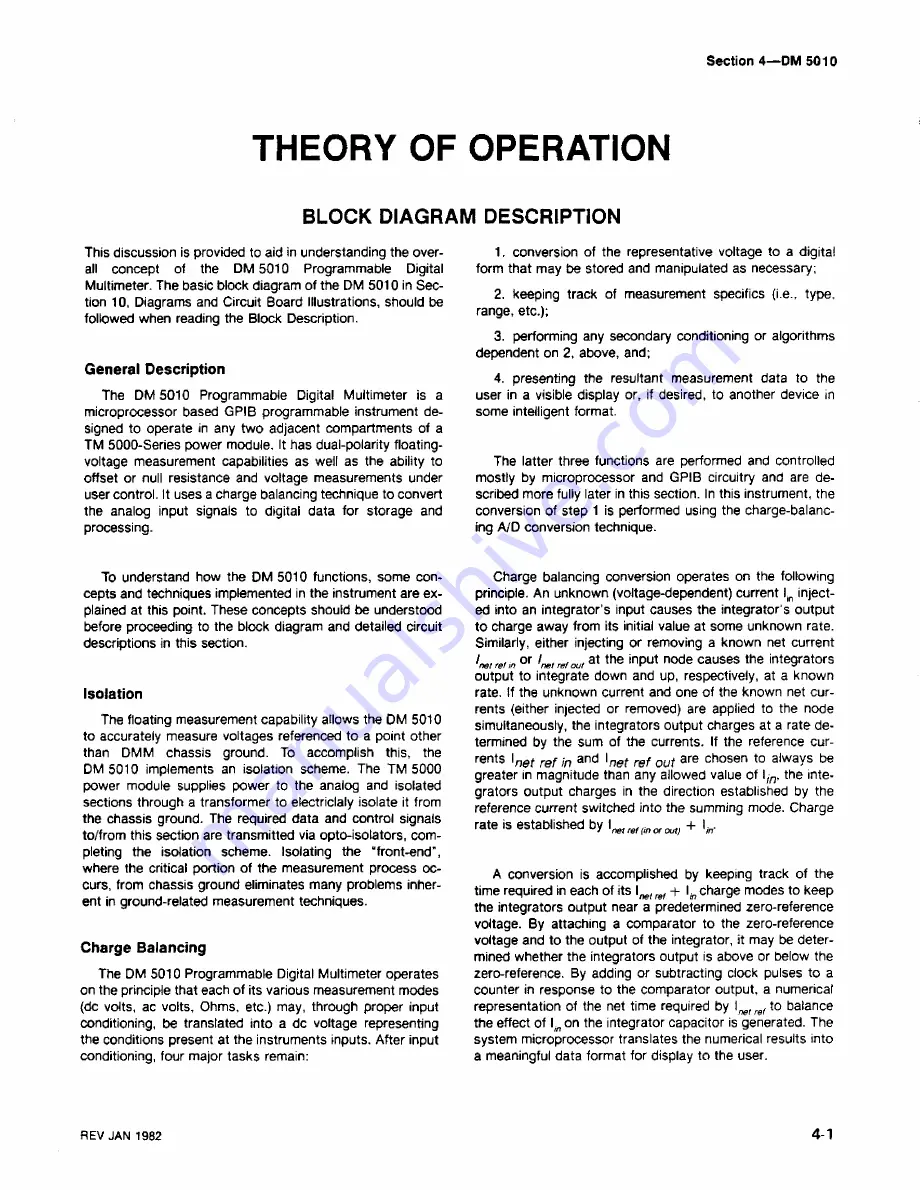
Section
4—
DM 5010
THEORY
OF
OPERATION
BLOCK DIAGRAM DESCRIPTION
This discussion is
provided to aid
in understanding the over
all concept
of the DM5010 Programmable Digital
Multimeter. The basic block
diagram of the DM 5010 in Sec
tion 10,
Diagrams and Circuit Board Illustrations, should be
followed
when
reading the Block Description.
General Description
The
DM5010 Programmable Digital Multimeter is a
microprocessor based GPIB programmable instrument de
signed to
operate in
any two adjacent compartments of a
TM
5000-Series
power
module. It has dual-polarity floating
voltage
measurement capabilities as well as the ability to
offset or
null resistance and
voltage measurements under
user control. It uses
a charge balancing technique to convert
the analog
input
signals to digital data for storage and
processing.
To
understand how the DM 5010 functions, some con
cepts and
techniques implemented
in the instrument are ex
plained
at this point. These concepts should
be understood
before
proceeding to the block diagram
and detailed circuit
descriptions
in this section.
Isolation
The floating measurement capability allows the DM 5010
to
accurately measure voltages referenced to
a point other
than
DMM
chassis
ground. To accomplish this, the
DM 5010
implements an isolation scheme. The TM 5000
power
module supplies power
to the analog and isolated
sections through
a transformer to electriclaly isolate it from
the
chassis ground.
The required data and control signals
to/from
this
section
are transmitted via
opto-isolators, com
pleting
the isolation scheme. Isolating the “front-end",
where
the critical portion of the measurement process oc
curs, from
chassis ground
eliminates many problems inher
ent
in ground-related measurement techniques.
Charge Balancing
The DM 5010 Programmable Digital Multimeter operates
on
the
principle that
each of its various measurement modes
(de volts, ac
volts,
Ohms, etc.) may, through proper input
conditioning, be
translated into a de voltage representing
the conditions present
at the instruments inputs. After input
conditioning,
four major tasks remain:
1. conversion
of the representative voltage to a digital
form
that may be stored and manipulated as necessary;
2. keeping track of
measurement specifics (i.e., type,
range,
etc.);
3. performing any secondary conditioning or algorithms
dependent
on 2,
above,
and;
4. presenting the
resultant measurement data to the
user
in a visible display or, if desired,
to another device in
some
intelligent format.
The
latter three functions
are performed and controlled
mostly
by microprocessor and GPIB circuitry and are de
scribed
more
fully
later in this section.
In this instrument, the
conversion
of
step 1 is performed
using the charge-balanc
ing A/D conversion technique.
Charge
balancing conversion operates on the following
principle. An unknown (voltage-dependent) current lin inject
ed into
an integrator’s input causes the integrator’
s output
to charge
away from its
initial value at some unknown
rate.
Similarly,
either injecting
or removing a known net current
Inet ref in or I
net ref
out
at the input node causes the
integrators
output to integrate down
and up,
respectively, at a known
rate.
If the unknown current and one of the known net cur
rents
(either injected
or removed) are applied to the node
simultaneously, the integrators output
charges at a rate de
termined
by the sum of the currents. If the reference cur
rents
Inet ref in
and
lnet ref out are chosen
to always be
greater in magnitude
than any allowed value of \jn, the inte
grators
output
charges
in the direction established by the
reference
current switched into the
summing mode. Charge
rate is established by
+ l/h
-
A
conversion is accomplished by keeping track of the
time
required in
each of its I
net ref
+
Iin charge modes to keep
the integrators
output near
a predetermined zero-reference
voltage.
By attaching
a
comparator to the zero-reference
voltage
and to the output of the integrator, it may be deter
mined whether
the
integrators output is above or below the
zero-reference. By
adding or subtracting clock
pulses to a
counter
in response to the comparator output, a numerical
representation
of
the net time required
by I net ref to balance
the
effect of
Iin on the integrator capacitor is generated. The
system
microprocessor translates the numerical results
into
a meaningful data
format for display to the user.
REV
JAN
1982
4-1
Summary of Contents for DM 5010
Page 14: ...DM 5010 2994 00 DM 5010 Programmable Digital Multimeter xii ADD JUL 1986...
Page 27: ...Operating Instructions DM 5010 2994 03 Fig 2 3 DM 5010 front panel controls and connectors 2 3...
Page 38: ......
Page 134: ......
Page 208: ......
Page 222: ......
Page 250: ......
Page 251: ...Section 8 DM 5010 OPTIONS No options are available 8 1...
Page 252: ......
Page 270: ......
Page 272: ...DM 5010 2994 37 Fig 10 2 Location of DM 5010 adjustments and test points...
Page 273: ......
Page 274: ......
Page 275: ......
Page 276: ...DM 5010 2994 112 DM 5010 BLOCK DIAGRAM...
Page 281: ......
Page 282: ......
Page 291: ......
Page 293: ......
Page 294: ......
Page 297: ......
Page 298: ......
Page 303: ......
Page 304: ...I...
Page 305: ......
Page 310: ......
Page 311: ......
Page 315: ......
Page 318: ......
Page 321: ......
Page 323: ......
Page 326: ......
Page 332: ...2994 57...
Page 334: ......
Page 335: ......
Page 336: ......
Page 337: ...63 REV JUN 1986...
Page 338: ...FIG 1 EXPLODED DM 5010...
Page 339: ......
Page 340: ......
Page 341: ......
Page 347: ......






























